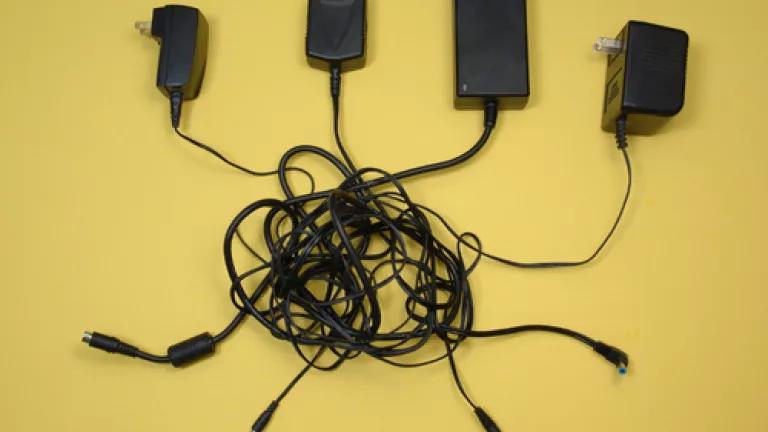
NRDC commends the U.S. Department of Energy (DOE) for issuing new efficiency standards for external power supplies – those black boxes that connect many of our electronic and other household devices to wall outlets – which will save Americans $300 million annually in the form of reduced electricity bills and avoid the need for a large (500 MW) power plant, reducing the toxic air pollution that impacts our health and the carbon pollution that destabilizes our climate. It is a great step forward to meeting President Obama's climate action plan goal of 3 billion tons of greenhouse gas emissions reductions from appliance efficiency standards by 2030.
What are external power supplies?
External power supply (EPS) is the fancy term for the more than 300 MILLION “wall warts”, “power bricks” and other “power adapters” shipped annually in the United States to be used by our phones, laptops, electric toothbrushes and power drills. Every product powered by electricity requires the conversion of the power from the wall outlet (110 volts) to a lower power used internally by the device. Given that the average American home has 5 to 10 EPS, making them 33 percent more efficient will result in huge power and monetary savings. While some larger devices convert wall power internally using an internal power supply, smaller electronic devices, power tools and personal care products typically use an external power supply.
EPS use a substantial amount of electricity nationwide
External power supplies consume electricity in two main ways:
- In “No Load” when the EPS is plugged in but the device is disconnected, for example when you disconnect your phone from its adapter but leave the adapter plugged into the wall. In this mode, the EPS draws a small amount of current over a long period of time (often 24/7), which adds up.
- In active mode, where the power conversion process wastes anywhere between 10 to 50 percent of the power drawn by the device while in active use. There were 345 million new EPSs sold in the US in 2009, and there are probably well over 1 billion in use today throughout the country! While most consume a modest amount of energy individually, they add up and in aggregate are responsible for several power plants worth of electricity consumption.
How do the new standards differ from the current ones?
Some external power supplies are already covered by the 2008 federal efficiency standards, however these standards cover only a limited portion of the market, and their energy-saving requirements are now outdated. Today’s technology can achieve much deeper reductions in the energy wasted by EPSs in a cost-effective manner, meaning saving more money to the consumer than they cost extra to manufacture (most often the extra cost is zero once the EPS has been redesigned and is manufactured at scale). The new DOE standards, which are due to become effective in two years, extend existing federal standards to almost all types of EPS, and also increase efficiency requirements on previously covered EPS devices. This is good news for American consumers who will enjoy lower electricity bills, and reduced carbon and air pollution as a result of these standards.
NRDC’s historic role on the efficiency of EPS
NRDC performed the first ever study of power supply energy consumption over 10 years ago, highlighting the savings potential by switching to more efficient EPS. We led the development of the first test method for EPS, and worked with the government-backed ENERGY STAR® program and the California Energy Commission to write the first mandatory standards worldwide.
NRDC also led the creation of a marking protocol, a small mark on the product that wraps the detailed requirements of the standards into a simple roman numeral indicating the EPS efficiency level. This EPS marking protocol was instituted around the world by all the leading electronics companies, and was instrumental in helping other countries adopt EPS efficiency requirements. The more countries adopt standards to cut energy waste, the quicker the market transforms, leading to the more efficient power supplies becoming the default at the same or lower cost than their predecessors. We commend DOE for extending the marking protocol with a new level called "Level VI", corresponding to the new federal EPS standards.
How about battery chargers?
Initially, the U.S. Department of Energy (DOE) included both external power supplies (EPS) and battery charger systems (BCS) in the same rulemaking; however the new rule issued today only covers external power supplies. DOE also indicates that it is further evaluating the impacts associated with the California standards, which we are confident will justify higher levels of efficiency for battery chargers than initially proposed in March 2012. The separation of the EPS and BCS rules is great news for energy savings. It follows NRDC’s recommendation submitted last May 2013. Our motivation was to to capture the savings from the EPS rule as early as possible while strengthening the proposed BCS standards in light of California’s newly implemented battery charger standards for consumer products with rechargeable batteries, such as cell phones, tablets, cordless drills, and electric shavers. Our colleagues at the Appliance Standards Awareness Project agree, and we remain optimistic that DOE will proposed more stringent standards for battery chargers in the upcoming months, extending the energy savings currently enjoyed by Californians to the entire nation.
